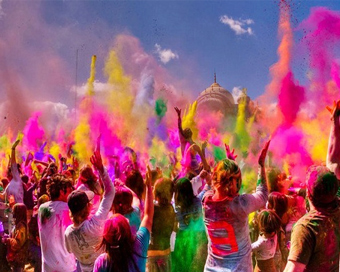 PM Modi visit USA
PM Modi visit USA Only the mirror in my washroom and phone gallery see the crazy me : Sara Khan
Only the mirror in my washroom and phone gallery see the crazy me : Sara Khan Karnataka rain fury: Photos of flooded streets, uprooted trees
Karnataka rain fury: Photos of flooded streets, uprooted trees Cannes 2022: Deepika Padukone stuns at the French Riviera in Sabyasachi outfit
Cannes 2022: Deepika Padukone stuns at the French Riviera in Sabyasachi outfit Ranbir Kapoor And Alia Bhatt's Wedding Pics - Sealed With A Kiss
Ranbir Kapoor And Alia Bhatt's Wedding Pics - Sealed With A Kiss Oscars 2022: Every Academy Award Winner
Oscars 2022: Every Academy Award Winner Shane Warne (1969-2022): Australian cricket legend's life in pictures
Shane Warne (1969-2022): Australian cricket legend's life in pictures Photos: What Russia's invasion of Ukraine looks like on the ground
Photos: What Russia's invasion of Ukraine looks like on the ground Lata Mangeshkar (1929-2022): A pictorial tribute to the 'Nightingale of India'
Lata Mangeshkar (1929-2022): A pictorial tribute to the 'Nightingale of India' PM Modi unveils 216-feet tall Statue of Equality in Hyderabad (PHOTOS)
PM Modi unveils 216-feet tall Statue of Equality in Hyderabad (PHOTOS)The Badminton Association of India (BAI) has announced a 14-member-strong India squad for
- Men’s Sr Hockey Nationals to be played in division-based format from April 4
- Mensik denies Djokovic 100th title in Miami final
- KIPG: Son of a vegetable vendor, Bihar’s Jhandu Kumar eyes Worlds, 2028 Paralympics
- Hardik Singh credits hard work and team unity for receiving HI Midfielder of the Year award
- Djokovic, Alcaraz land in same half of Miami draw
Choose wisely - go organic this Holi! Last Updated : 20 Mar 2019 01:02:51 PM IST 
Choose wisely - go organic this Holi! (File photo) With Holi -the festival of colours coming up -- everyone is busy buying colours, 'pichkaris', and balloons but with increasing environment pollution and severe allergic reactions to synthetic colours, there is a growing awareness among people to opt for organic variants.
"In an approximately Rs 4,500-crore unorganised Holi colour market, the share of the organic variety is miniscule, but growing," said Madhumita Puri, Founder and Executive Director of Avacayam Naturals, a Delhi-based manufacturer of organic colours.
The adverse effects of synthetic colours was observed in a study titled 'The Holi Dermatoses', published in the Indian Journal of Dermatology.
It found a spate in skin diseases following the spring festival in India.
In the study conducted on 42 patients in Kolkata, 11 patients suffered due to activities related to preparation of colors and 12 reported aggravation of pre-existing dermatoses.
Nearly 60 per cent patients reported itching, while others reported to have suffered from a burning sensation, scaling, redness and watering of the eyes, as per the study.
Treading on a eco-friendly and skin-friendly path, Avacayam Naturals employed differently-abled persons to make organic colours by using waste and used flowers and leaves.
This solves three purposes at one go - generates employment for the disabled, manufactures harmless eco-friendly colours, and there is optimal usage of waste flowers.
Puri said: "For making the colours, we collect used flowers -- roses, marigolds, and others -- and leaves from temples, weddings, and hotels."
Avacayam Naturals, one of the programs that Puri started under her "Trash to Cash" scheme, makes four colours: Pink from roses, yellow from yellow marigolds, orange from orange marigolds, and green from leaves.
On being asked if the colours are harmless, she said: "Rather than damaging the environment, they are beneficial as each packet of colour is made from waste flowers which otherwise would dirty the place."
How are the colours made?
"After the flowers are collected, the workers sort them in different baskets according to their colour. Then, the petals and seed pods are separated and cut. These are then spread out to dry in a well ventilated space for all the moisture to evaporate.
"After that, they are ground and processed -- without adding any chemicals -- to be made into colours for people to enjoy," Puri said, adding that the process of collection, drying, and grinding continues throughout the year but it is only before festivals that they process them into the final product.
"In a year, we manufacture around 20 tonne of pure organic colour, some of which is sold to Walmart India. One kilo of colour is sold between Rs 600 and Rs 1,000."
When asked about the expiry date of these colours, Puri said: "The product is a dry one and completely natural. We have been testing them since five years now and have not found any deterioration in the quality, fungal infestations, or weevils.
So there is no 'expiry date' to them."
Another such manufacturer is Jaipur-based Red Earth which makes colours "exclusively from edible materials and scent them with pure, traditional attars".
Speaking to IANS, Himanshu Verma, Director-Owner of Red Earth, said: "Every 2-3 years, we change our colour palette...
this year we have four colours -- Sunahra Dhamaal, Shvet Abeer, Neem Sanrachna, and Gulabi Nagariya -- that are inspired by local materials."
"The colours are curated on the basis of availability of local materials. We use items like camphor, neem, mehendi, multani-mitti, geru powder, arrowroot, flour, and others," Verma said, adding that 50-60 per cent materials used are edible so that even if someone ingests them by mistake, they will not be as harmful.IANS For Latest Updates Please-
Join us on
Follow us on








172.31.16.186







